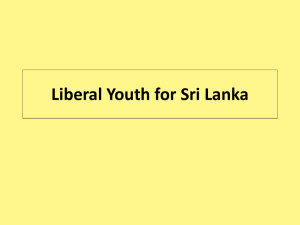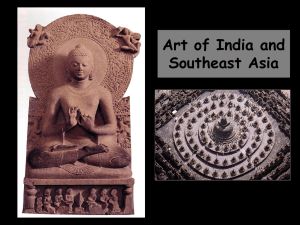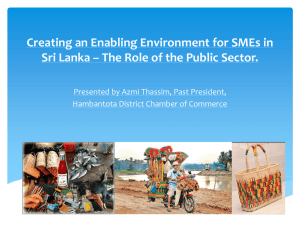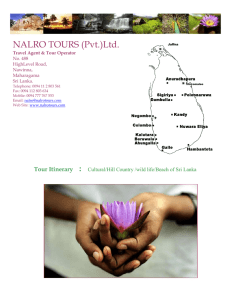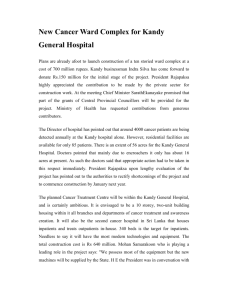Sacred City of Kandy
advertisement
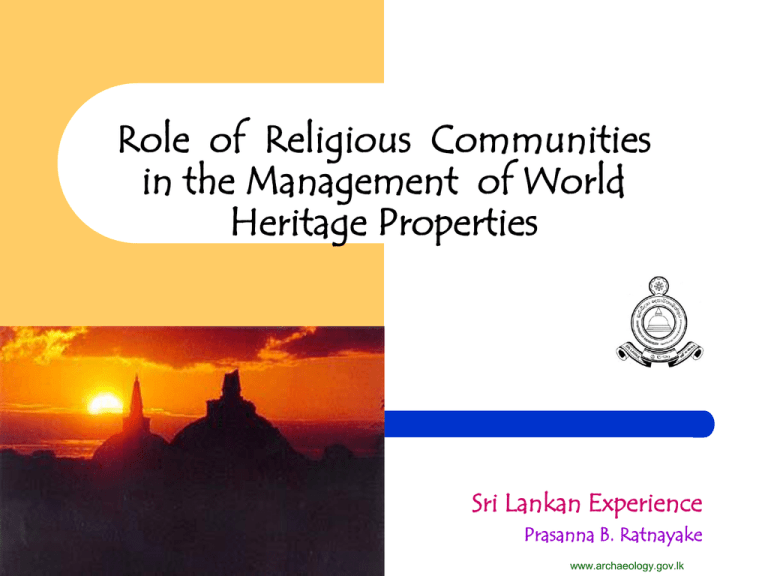
Role of Religious Communities in the Management of World Heritage Properties Sri Lankan Experience Prasanna B. Ratnayake www.archaeology.gov.lk Sri Lanka Sri Lanka is an Island, South to Indian Sub continent Area – 65000 Sq. Km 20 million Population 70% Buddhists 15% Hindus 7.5% Islamic 7.5 Catholics Archaeological Heritage is Managed by the Department of Archaeology under the Antiquities Ordianance World Heritage Sites in Sri Lanka Cultural Sites – – – – – – Sacred City of Anuradhapura (Inscribed in 1982) Ancient City of Sigiriya (Inscribed in 1982) Sacred City of Polonnaruwa (Inscribed in 1982) Sacred City of Kandy (Inscribed in 1988) Old Town of Galle and its Fortifications (Inscribed in 1988) Golden Temple of Dambulla (Inscribed in 1991) Natural Sites – – Sinharaja Natural Forest Reserve (Inscribed in 1988) Central Highlands of Sri Lanka (Inscribed in 2010) Sacred City of Anuradhapura Ancient City of Sigiriya Sacred City of Polonnaruwa Sacred City of Kandy Old Town of Galle and its Fortifications Golden Temple of Dambulla Management of World Heritage (Cultural)Sites in Sri Lanka Legal Authorities– – Under the Antiquities ordinance- Department of Archaeology Management is supported by Central Cultural Fund Ownerships – – – Temple Authorities, Government Building owners ( Galle) Level of involvement in the Management by the religious community Property Institutional Involvement Community Involvement Religious Community Involvement Anuradhapura High High High Polonnaruwa High Low Low Sigiriya High Medium Low Kandy High High High Dambulla High Low High Galle High High Nil Type of religious Involvement Property Type of religious Involvement Anuradhapura Ownership Rituals Pilgrims’ needs (Local) Kandy Ownership Continuing Traditions Maintenance needs Pilgrims’ needs (Local and Foreign) Political Patronage Dambulla Ownership Rituals Development Needs Property Management Religious Involvement All three sites are related to Buddhism Buddhism in Sri Lanka Buddhism was introduced to Sri Lanka in 3rd Century BC by Arahant Mahinda, son of Emperor Asoka Buddhism in Sri Lanka The Buddhist traditions were strengthened after the visit of Arahant Sangamitta, daughter of Emperor Asoka, who brought the sapling of Sacred Bodhi tree, together with 18 different groups of people skilled in various arts and crafts. Buddhism as a philosophy Buddha was born in Lumbini in present Nepal and attained enlightenment and in 6th century BC. His teachings is Known as Dhamma. His teachings are continuing by the monks, who are called Sangha. Buddha, dhamma. Sanga known as – Triple Gem in Buddhism: Most precious Tradition of Pilgrimage In Maha Parinibbana Sutta ( The story of the Buddha’s demise) advocates pilgrimages to four places The Buddha’s birth place - Lumbini Where he attained enlightenment – Bodh-Gaya Place he delivered first discourse - Isipathana Where the death occurred - Kusinara Buddhist Heritage Buddhist Heritage can be understood in three categories – – – Intellectual – The plethora of writings containing the teachings of the Buddha Intangible –The rituals, and other forms of acts of the followers of the faith Tangible – the ritual buildings, monasteries, sculptures and paintings Three kinds of Shrines in Buddhism The Bodhi Tree (Ficus religiosa) – The tree which provided shelter for Buddha in enlightenment The Stupa – where keep the bodily relics of Buddha or the followers who attained the highest status ( Arahant) The Image – Is the symbolic representation of Buddha Buddha’s teachings on Monasteries The Code of discipline (Vinaya) – Provides guidelines on Constructing Monastic Buildings – It allows Monks to involve in repair works of monasteries – It describes that dilapidated buildings are not suitable for the meditative life of Monks Manjusri Vastuvidyasasthra ( 6th Century AD) – Contains twenty seven typical monastic plans Mayamata( An Indian literature) – Contains a Chapter on restoration Traditional Conservation - 6 century AD A temple (may be) ruined, broken down, fallen down, aged as to its materials or decrepit. Those (temples) whose characteristics are still perceptible in their principal and secondary elements (are to be renovated) with their own materials. If they are lacking in anything or have some similar type of flaw, the sage wishing to restore them, (must proceed in such a way that) they regain their integrity and that they are pleasantly arranged (anew); this (is to be done) with the dimensions height and width – which were theirs, with decorations consisting of corner, elongated and other aedicule, without anything being added (to what originally existed) and always in conformity with the advice of the knowledgeable Traditional Conservation- 9TH century INSCRIPTION [There shall be] clever stone-cutters and skilful carpenters in the village devoted to the work of [temple] renewal. They all… shall be experts in their [respective] work. ….shall be granted to the officer who superintends work. …his respective duties, shall be recorded in the register. …….they alone shall be answerable for its correctness. The limit [of time] for the completion of work is two months and five days. Blame [shall be attributed to] … who do not perform it according to arrangement. The local experience The Mahavamsa (Great Chronicle) says about more than 100 incidents of repairing, restoration and renewal of monastic buildings The first stupa in Sri Lanka (The Thuparama ) Built in 3rd century BC, has renovated more than 16 times. It was a foremost duty of a newly crowned king to repair or renew a monastic building It is a meritorious act The Buddhists consider constructing monastic buildings and attending to repairs as meritorious acts. – The restoration of religious buildings was regarded as being so meritorious that, according to an inscription, monk sacrified his ration of food for the restoration of Jethawana stupa – Epigraphia Zelanica – 3. 132 1956 Restoration was a Responsibility King Parakramabahu ( 1153-1186 AD) sent a minister in charge of restoration to Anuradhapura King Nissankamalla ( 1187-1196 AD)appointed officer in charge of restoration – The post “Loke Arrakmena” in the inscription has been translated ias “ chief conservator of Monuments” King Kirthi Sri Rajasinghe (1747-1780 AD)sent a mission to repair the ruined temples in Anuradhapura A King who had neglected the Thuparama Stupa was threatened in a dream that, if the repairs were not attended the relics would be removed from. Maintenance The properties were granted to the monasteries for its regular maintenance. These were protected by law People had to pay taxes for occupying in those lands by contributing the regular maintenance, both in tangible and intangible aspects. This is practiced even today . Maintenance An inscription describes how to protect these lands – To the villages, royal officers and irrigation officers shall not enter. Those of the archery department, the tax officers, headmen in charge of districts and of provinces shall not enter. The employees of two offices, deruwana, perelaki, archers, guards, and those of the paid services shall not enter. Carts, oxen, laborers, imposts of cooked and raw rice, and periodical gifts of milk and oil should not be taken….having forbidden the entry of the aforesaid persons, we, two of us ( the two officers who planted the pillar) have given to these villages the immunities (sanctioned by) the council – Epigraphia Zeylanica – VOL 3, 105 Present Management issues Anuradhapura – Properties are owned by the monks – There are various rituals and festivals – Occasional facilities have to be provided Pilgrims’ needs have to be fulfilled – There are different requirements There are more than 2 million pilgrims visit on th efull moon day of June Traditional maintenance systems are weak in practice The area was abandoned for five centuries (12-17) Main festival in June (Poson) It is reported that more than 2 million pilgrims come to worship Anuradhapura in full moon of June every year to commemorate the visit of Arhant Mahinda Restoration Needs As per the Buddhist ritualistic practices there is a strong request to restore the Buddhist monuments from the community Ruwanweliseya – Before Restoration Ruwanweliseya – After Restoration The spiritual feeling There is a clear difference in rituals in these two places Ruwanweliseya Jethawana Stupa – The World’s Highest Present Management issues Dambulla – Property is owned by the priests – There are different modern needs from the management – Conservation of Mural paintings is less attended Present Management issues Kandy – – – – – – Ownership and Management is with the Priests and the temple Authorities Visited by thousands of Pilgrims daily, both Local and foreign Being a major tourist attraction there are several requirements to cater them. The annual cultural pageant (Perahera) attracts thousands of people, throughout the month of August, and there are various facilities to be provided for them Still surviving traditional maintenance system, Both Tangible and Intangible contradicts with the legal frameworks Political Interference and influence is High Present Management issues Kandy: pilgrimage is an issue Management issues at present Kandy: religious needs are part of the heritage Management issues at present Kandy: Highest political patronage due to religious significance Conclusions Religious community has played an important role in managing heritage We need to understand traditional management systems We need a greater dialogue with the religious community We need to account for the needs of the religious community We need to evolve new joint management systems together with the religious communities for sustaining heritage •References Past is in the present…. G. Wijesuriya - to be distributed The End Thank you for your attention



